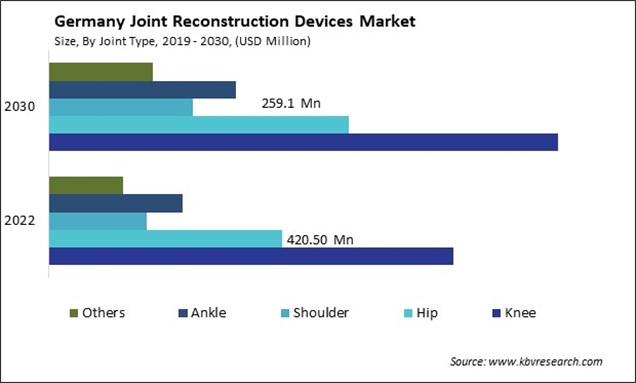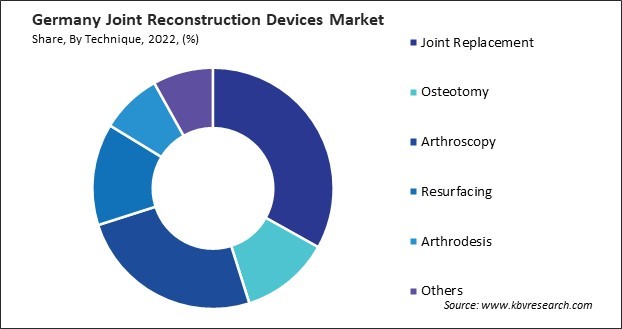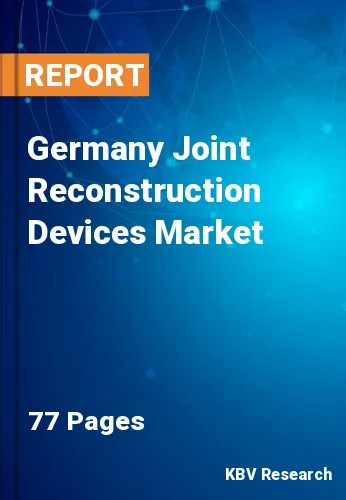The Germany Joint Reconstruction Devices Market size is expected to reach $2.2 Billion by 2030, rising at a market growth of 3.6% CAGR during the forecast period.
Germany's joint reconstruction devices market has witnessed significant growth and evolution in recent years, reflecting the country's commitment to providing advanced healthcare solutions. Germany is a key player in the global orthopedic devices industry, with joint reconstruction devices playing a pivotal role in addressing musculoskeletal disorders and injuries.

In recent years, Germany has witnessed a surge in outpatient joint replacement surgeries driven by advancements in minimally invasive techniques. This trend has reduced the length of hospital stays and contributed to the overall cost-effectiveness of joint reconstruction procedures. Additionally, integrating robotics and computer-assisted technologies has improved the precision of joint replacement surgeries, leading to better patient outcomes.
Health insurance coverage is pivotal in facilitating patient access to joint reconstruction procedures in Germany. The comprehensive nature of the country's healthcare system ensures that a significant portion of the population can avail themselves of orthopedic treatments without bearing the full financial burden. This accessibility factor further propels the demand for joint reconstruction devices, as patients are more likely to seek timely medical interventions.
The COVID-19 pandemic has profoundly impacted the healthcare landscape globally, including the joint reconstruction devices market in Germany. Despite the initial disruptions in elective surgeries and supply chain challenges, the pandemic has accelerated certain positive trends in the industry. The increased focus on telehealth services and digital health solutions has enabled healthcare providers to offer remote consultations and monitor patients' post-surgery recovery, enhancing overall patient care.
In recent years, Germany has witnessed a notable surge in the incidence of joint disorders, contributing to a growing demand for joint reconstruction devices market in medical. The aging demographic in Germany plays a significant role in the escalating prevalence of joint disorders. As the population ages, the likelihood of individuals developing conditions such as osteoarthritis and rheumatoid arthritis rises, leading to a higher demand for joint reconstruction devices. Germany's commitment to providing advanced healthcare services has also resulted in a proactive approach to addressing musculoskeletal issues, leading to increased diagnosis and subsequent treatment.
Moreover, lifestyle factors, including sedentary habits and obesity, have become prevalent in Germany, contributing to the rise in joint disorders. Modern work environments, characterized by prolonged periods of sitting and limited physical activity, have been linked to an increased risk of musculoskeletal issues. As a consequence, Germans are seeking joint reconstruction devices to restore mobility and alleviate pain associated with joint disorders.
Furthermore, Germany's emphasis on technological advancements and medical research has positioned it as a hub for developing and manufacturing cutting-edge joint reconstruction devices. German companies are at the forefront of creating innovative solutions, including prosthetics, implants, and surgical instruments, to restore mobility and enhance the quality of life for individuals with joint-related ailments.
According to the International Trade Administration, the German medical device industry is one of the most lucrative healthcare industries worldwide, accounting for roughly USD 42 billion annually, or 25% of the European industry total. In tandem with the thriving medical device landscape, the healthcare industry in Germany achieved a noteworthy gross value of EUR 439.6 billion in 2022. This solidifies Germany's standing as a healthcare powerhouse and positions the joint reconstruction devices market as a key driver of innovation and economic prosperity within the nation's healthcare landscape.
In Germany, the joint reconstruction devices market has witnessed a significant surge in awareness and patient education in recent years, marking a transformative shift in the healthcare landscape. One key driver of this heightened awareness is the proactive engagement of medical professionals in Germany. Orthopedic surgeons, in particular, have been instrumental in disseminating information about the latest joint reconstruction devices, surgical techniques, and rehabilitation methodologies.
Educational initiatives, seminars, and conferences dedicated to joint health have become commonplace, fostering a culture of continuous learning among healthcare providers. Patient education has emerged as a focal point in Germany's joint reconstruction landscape. Healthcare institutions and medical practitioners are increasingly investing in patient-centric communication strategies. Informative brochures, online resources, and interactive sessions aim to educate patients about joint disorders, available treatment options, and the importance of early intervention.
The integration of telemedicine and virtual care platforms has further expanded access to information, allowing patients to engage with healthcare professionals remotely in Germany. This has proven particularly beneficial in the post-operative phase, enabling patients to receive guidance on rehabilitation exercises and recovery milestones from the comfort of their homes. Therefore, Germany's joint reconstruction devices market has experienced a notable surge in awareness driven by proactive engagement from medical professionals, particularly orthopedic surgeons.

Germany's joint reconstruction devices market is a dynamic and rapidly evolving sector, driven by factors such as an aging population, increasing prevalence of musculoskeletal disorders, and advancements in medical technology. One of the key players in the German joint reconstruction devices market is Siemens Healthineers. Leveraging its expertise in medical imaging and diagnostics, Siemens offers a range of solutions for joint reconstruction, including advanced imaging technologies for preoperative planning and intraoperative guidance. The company's commitment to innovation has positioned it as a major player in the orthopedic surgery segment.
Another significant contributor to the industry is Stryker Corporation. With a diversified portfolio of joint replacement products, Stryker has established itself as Germany's leading orthopedic solutions provider. The company focuses on developing cutting-edge implants and instruments that enhance surgical outcomes and patient satisfaction. Stryker's commitment to research and development ensures a continuous stream of innovative products catering to the evolving needs of healthcare professionals.
DePuy Synthes, a subsidiary of Johnson & Johnson, is a prominent player in the German joint reconstruction devices market. The company's comprehensive range of orthopedic solutions spans joint replacement, trauma, and spine surgery. DePuy Synthes is known for its high-quality implants and commitment to providing integrated solutions that address the entire continuum of patient care in joint reconstruction.
Another significant player, Zimmer Biomet, offers a broad spectrum of joint reconstruction devices in the German industry. The company's product portfolio includes implants for hip, knee, and shoulder replacements, along with associated instruments and technologies. Zimmer Biomet's focus on patient-specific solutions and personalized orthopedics contributes to its strong presence in joint reconstruction.
In addition to these multinational giants, several German companies play a vital role in the domestic joint reconstruction devices market. Aesculap, a division of the B. Braun Group, is recognized for its orthopedic implants and instruments. The company's focus on precision engineering and commitment to quality has made it a preferred choice among healthcare professionals in Germany.
LINK Medical, a German manufacturer specializing in orthopedic implants, is known for its dedication to research and development. The company's focus on innovative solutions for joint reconstruction contributes to its prominence in the German industry. Hence, the joint reconstruction devices market in Germany is characterized by a mix of multinational corporations and local players, each contributing to the advancement of orthopedic care.
By Joint Type
By Technique
Our team of dedicated experts can provide you with attractive expansion opportunities for your business.

